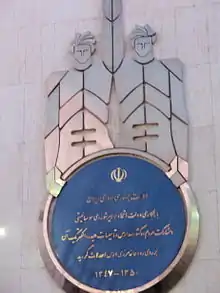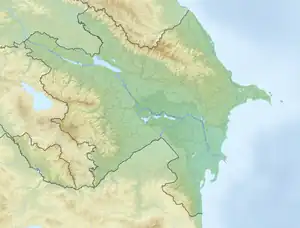| Aras Dam | |
|---|---|
 The memorial plate of Aras dam in Jolfa | |
 Location of the Aras Dam on the border of Azerbaijan and Iran | |
| Country | Iran Azerbaijan |
| Location | Poldasht, Nakhchivan |
| Coordinates | 39°05′28″N 45°24′08″E / 39.09111°N 45.40222°E |
| Status | Operational |
| Construction began | 1964 |
| Opening date | 1971 |
| Dam and spillways | |
| Height | 40 m (130 ft) |
| Length | 1,026 m (3,366 ft) |
| Width (crest) | 8 m (26 ft) |
| Spillway capacity | 66.5 m3/s (2,350 cu ft/s) |
| Reservoir | |
| Creates | Aras Reservoir |
| Total capacity | 1.35 km3 (1,090,000 acre⋅ft) |
| Surface area | 145 km2 (56 sq mi) |
| Power Station | |
| Operator(s) | Azerenerji Iran Water Resources Management Company |
| Commission date | 1971 |
| Turbines | 4 × 11 MW (15,000 hp) |
| Installed capacity | 44 MW (59,000 hp) |
The Aras Dam (Azerbaijani: Araz su anbarı; Persian: سد ارس) is an embankment dam on the Aras River along the border of Iran and Azerbaijan. It is located downstream of Poldasht in West Azerbaijan Province, Iran and Nakhchivan City in Nakhchivan Autonomous Republic, Azerbaijan. The primary purpose of the dam is hydroelectric power generation and water supply.
History
On 11 August 1957, a protocol was signed between the Soviet Union and Iran in Tehran to construct the Aras Dam on the Aras River.[1] This was done at a time when Azerbaijan was under Soviet control. Construction on the dam began in 1963 and was completed in 1970.[2] The dam was officially inaugurated on 28 June 1971 by Iranian deputy prime minister Safi Asfia and the Deputy Chairman of the Soviet Council of Ministers Mikhail Yefremov.[3]
A supplementary protocol to the border agreement of 1954 between Iran and the Soviet Union was signed on 7 May 1970 in Moscow to redelimit the border along the Aras Reservoir.[4]
Specifications
Dam
The Aras Dam is 40 metres (130 ft) tall from its foundation and 34 metres (112 ft) tall from the riverbed.[2] It is an embankment type dam with sand fill and a clay core. It is 1,026 metres (3,366 ft) long and 8 metres (26 ft) wide on its crest.[2]
Reservoir
The Aras Reservoir (Azerbaijani: Araz su anbarı), also known as Aras Water Junction (Azerbaijani: Araz Su Qovsağı), is a large reservoir created by the Aras Dam and shared by Nakhchivan exclave of Azerbaijan Republic and Iran.
At a normal water elevation of 777.5 metres (2,551 ft) above sea level, the dam withholds a reservoir of 1.35 cubic kilometres (1,090,000 acre⋅ft) with a surface area of 145 square kilometres (56 sq mi).[2][5] Of the reservoir's normal capacity, 1.15 cubic kilometres (930,000 acre⋅ft) of it is active or "useful" while 0.2 cubic kilometres (160,000 acre⋅ft) is inactive or dead storage. The maximum storage of the reservoir is 1.75 cubic kilometres (1,420,000 acre⋅ft).[2] The reservoir is 52 kilometres (32 mi) long and 6.1 kilometres (3.8 mi) wide. The average depth at normal water levels is 18.2 metres (60 ft).[6]
There are a total of four hydro-electric stations in Azerbaijan and Iran (two on each side) with four turbines. The discharge capacity of one spillway of a station is 66.5 m3/s (2,350 cu ft/s).[6]
Since its opening, the reservoir has provided irrigation water for 400,000 hectares (990,000 acres) of arable land in Azerbaijan and Iran, including about 60,000 hectares (150,000 acres) in Dasht-e Moghan area.[6][7]
Power station
The dam's power station contains four turbine-generators for a capacity of 11 megawatts (15,000 hp) each. Two of the generators are on the Iranian side and the other two on the Azerbaijani side along with the dam's spillway.[2] The discharge capacity of one spillway of a station is 66.5 cubic metres per second (2,350 cu ft/s).[6] The total installed capacity is 44 MW.[8]
See also
References
- ↑ "Agreement between Iran and the Soviet Union for the joint utilisation of the frontier parts of the rivers Aras and Atrak for irrigation and power generation" (PDF). Iran, USSR. Archived from the original (PDF) on 23 July 2011. Retrieved 29 January 2011.
- 1 2 3 4 5 6 Filipuzzi, Serena; Faramarzi, Monireh (March 2007). The Science and Politics of Large Dam Project Aras river basin: dam facility and water management policy. An analysis on performance (PDF). Eawag. Retrieved 29 January 2011.
- ↑ Collard, Elizabeth (1971). Middle East economic digest. Vol. 15. I.B.Tauris. p. 772.
- ↑ "Iran – U.S.S.R. Boundary" (PDF). International Boundary Study. The Geographer (25): 6. 1978-02-28. Archived from the original (PDF) on 2012-05-09. Retrieved 2011-01-29.
- ↑ "Information on Water Reservoirs". Water resources database. Archived from the original on 2011-07-10. Retrieved 2011-02-15.
- 1 2 3 4 "Su anbarlari" [Water reservoirs] (in Azerbaijani). Melioration. Archived from the original on 2011-01-19. Retrieved 2011-02-15.
- ↑ McLachlan, Keith Stanley (1988). The neglected garden: the politics and ecology of agriculture in Iran. I.B.Tauris. p. 135. ISBN 978-1-85043-045-2.
- ↑ World water. Vol. 12. T. Telford Ltd. 1989. p. cxxxv.